-
Countries
-
Data and Analysis
-
Special Focus
-
Crisis Responses
Baseline Assessment
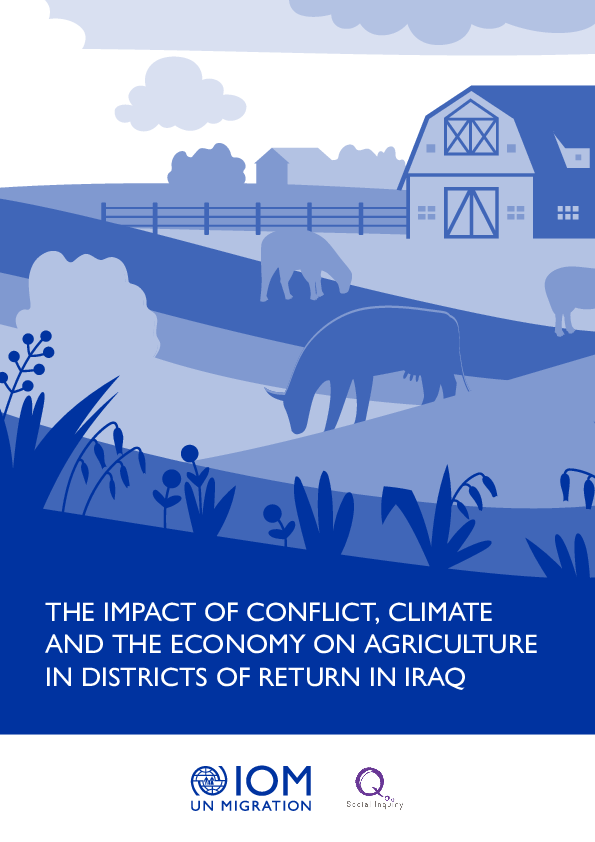
Contact
DTM Iraq, IraqDTM@iom.int
Language
English
Location
Iraq
Period Covered
Mar 01 2022
Apr 30 2022
Activity
- Survey
- Return Intention
- Mobility Tracking
- Baseline Assessment
This brief is part of a larger research project, Reimagining Reintegration, carried out by IOM Iraq and Social Inquiry, that explores the sustainability of returns across 14 districts hosting the largest shares of returnees in the country. These are, in descending order of returns, Mosul, Ramadi, Falluja, Telafar, Tikrit, Heet, Hawija, Hamdaniya, Shirqat, Kirkuk, Baiji, Sinjar, Khanaqin, and Balad. The findings presented here are drawn from an original household survey and roster of 2,260 returnee respondents in these districts collected between March and April 2022. The survey included a household module (applicable to the overall household situation), a personal module (gathering perceptions of the respondent), and a roster module (collecting personal characteristics of each household member), covering topics related to demographics, displacement and conflict history, safety and security, adequate standards of living, livelihoods and economic conditions, housing condition/restitution and tenure security, civil documentation, social cohesion and public participation, and remedies and justice. The outputs of this project also include an analysis of sustainable reintegration in districts of return and another brief on differences between male- and female-headed households and their implications for sustainable return.
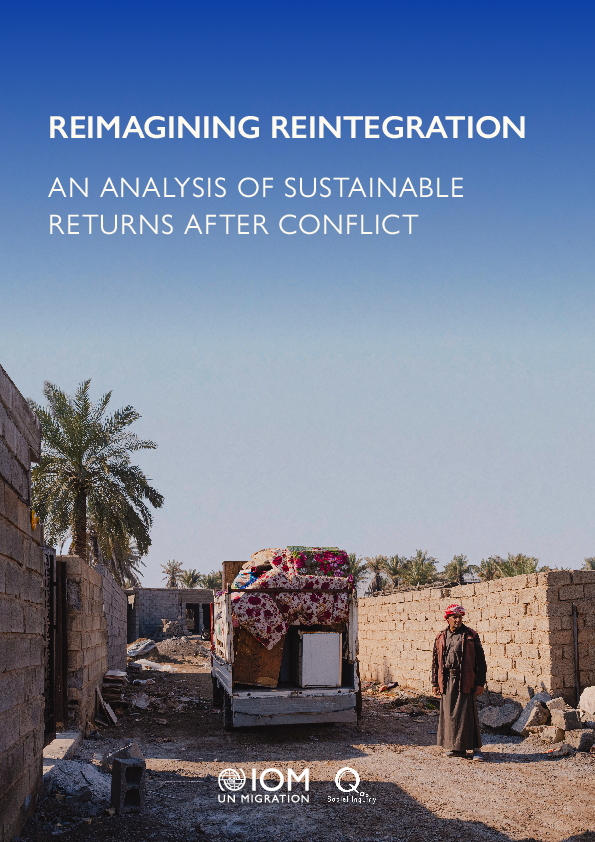
Contact
DTM Iraq, IraqDTM@iom.int
Language
English
Location
Iraq
Snapshot Date
Mar 22 2022
Activity
- Survey
- Return Intention
- Mobility Tracking
- Baseline Assessment
This report presents an overview of reintegration of returnees across the top 14 districts with the largest number of returnees; altogether, they represent more than 80% of the almost 5 million returnees that IOM’s Displacement Tracking Matrix estimated in March 20221 . This research was designed to obtain a statistically representative sample of the returnee population in each district with at most a 10% margin of error within a 95% confidence interval.

Contact
DTM Iraq, IraqDTM@iom.int
Language
English
Location
Iraq
Snapshot Date
Dec 30 2022
Activity
- Survey
- Return Intention
- Mobility Tracking
- Baseline Assessment
In February 2021, IOM Iraq, the Returns Working Group and Social Inquiry produced a report,Home Again?. The report analyzed the sustainability of reintegration of Iraqi families who had returned to their area of origin after being displaced due to the ISIL conflict. In line with the durable solutions framework developed by the Expert Group on Refugee and IDP Statistics (EGRIS), the report examined the extent to which sustainable reintegration had taken place across five areas.9 The study found that the main challenges to reintegration relate to housing, land and property (HLP); safety, security and social relations; and access to livelihoods and economic security. In 2021, IOM published a report and set of district profiles related to HLP, as well as a report focused on safety, security and social relations. Taken together, this series of reintegration reports – including this report focused on livelihoods and economic security – provides a comprehensive evidence base in support of the advancement towards sustainable reintegration for the 825,372 returnee families across the country.
The objective of this report is to strengthen the evidence-base related to the types of reintegration challenges related to livelihoods and economic security that returnees face across the country. The analysis is structured around the two relevant sub-criteria from the EGRIS framework, as follows: Livelihoods and employment and Economic Security.
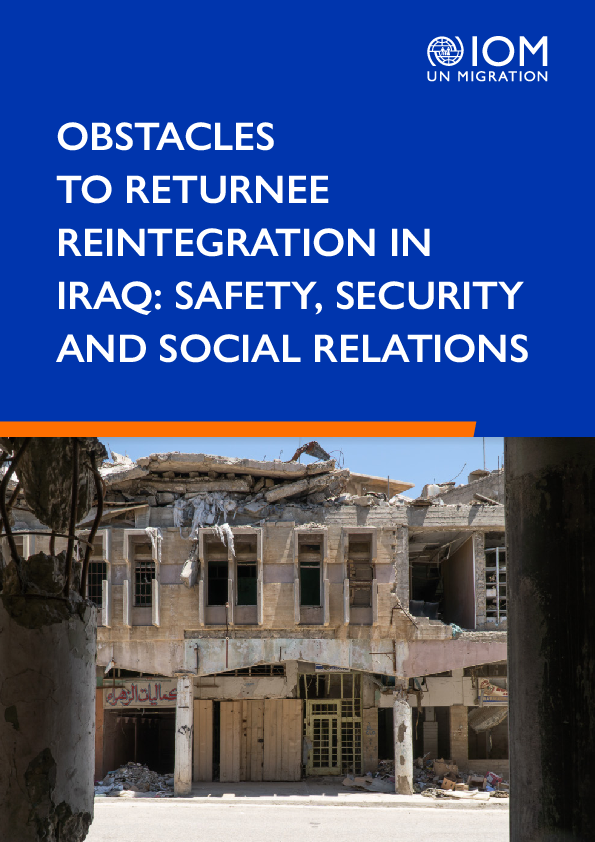
Contact
DTM Iraq, IraqDTM@iom.int
Language
English
Location
Iraq
Period Covered
Oct 01 2020
Sep 30 2021
Activity
- Survey
- Return Intention
- Mobility Tracking
- Baseline Assessment
In February 2021, IOM Iraq, the Returns Working Group and Social Inquiry produced a report, Home Again? Categorising Obstacles to Returnee Reintegration in Iraq. It analyzed the sustainability of reintegration for families who had returned to their area of origin after being displaced due to the ISIL conflict.5 In line with the durable solutions framework developed by the Expert Group on Refugee and IDP Statistics (EGRIS), the report examined the extent to which sustainable reintegration had taken place across five areas.6 Persistent issues related to safety, security and social relations were found to represent the most significant barriers to achieving sustainable reintegration amongst returnees in Iraq.
The objective of this report is to inform strategy development and planning in support of the sustainable reintegration of returnees in their area of origin. It provides a snapshot of the key reintegration challenges that returnees face related to safety, security and social relations, and highlights areas where these challenges are most prevalent. Where there is longitudinal data, the report also demonstrates how conditions have changed in the period between October 2020 and September 2021.
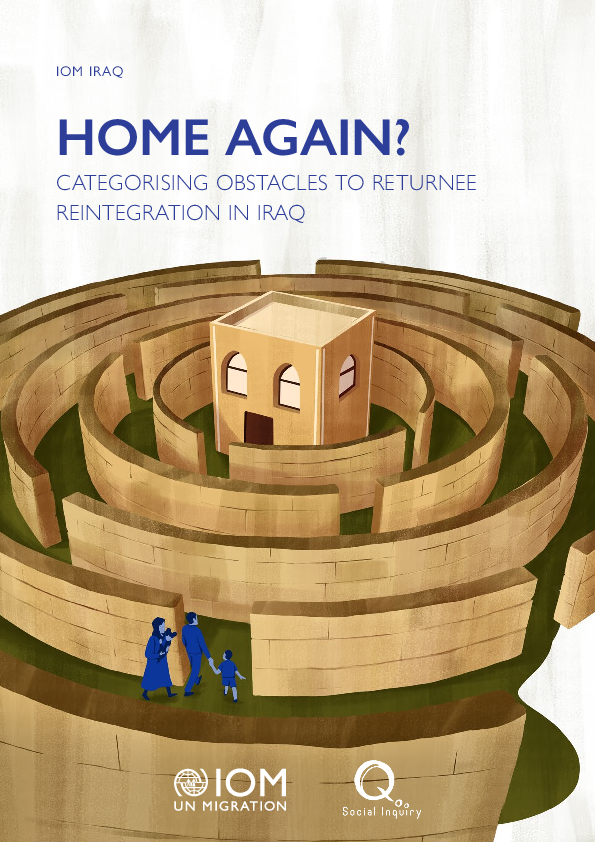
Contact
DTM Iraq, IraqDTM@iom.int
Language
English
Location
Iraq
Snapshot Date
Dec 31 2020
Activity
- Survey
- Return Intention
- Mobility Tracking
- Baseline Assessment
This report examines the prevalence of key obstacles for reintegration that returnee households face in Iraq as of mid-2020. These obstacles are grouped into five main criteria, as follows: safety, security & social relations, access to livelihoods & economic security, documentation, property resitution & compensation and adequate standard of living.
As of December 2020, Iraq has witnessed the return of 4.8 million internally displaced persons (IDPs) to their places of origin in the aftermath of the ISIL conflict. 1 Inter-Agency Standing Committee, IASC Framework on Durable Solutions for Internally Displaced Persons. Expert Group on Refugee and IDP Statistics, International Recommendations on IDP Statistics, background document to fifty-first session of the UN Statistical Commission, 3-6 March 2020. This is a significant returnee population and, while the movement home is a first step toward reintegration, it is not necessarily an indication of longer-term sustainability per se.1 The analysis in this report, by IOM Iraq, the Returns Working Group (RWG), and Social Inquiry, builds upon on and complements previous assessments on durable solutions, mainly with regards to obstacles to return as well as progress toward local integration for IDPs. The focus here is specifically on returnees and obstacles to their sustainable reintegration upon return.

Contact
DTMUkraine@iom.int
Language
English
Location
Ukraine
Period Covered
Mar 01 2024
Mar 31 2024
Activity
- Baseline Assessment
Базова територіальна оцінка зареєстрованих ВПО надає деталізовані дані щодо чисельності та географічного розподілу офіційно зареєстрованих внутрішньо переміщених осіб (ВПО). У звіті оцінено присутність зареєстрованих ВПО на рівні громад із відображенням на мапі зафіксованих змін порівняно з попереднім раундом.
Дані, зібрані для раунду 34 Базової територіальної оцінки, відображають актуальну статистику з місцевого адміністративного реєстру ВПО станом на 31 березня 2024 року, згідно з якою в Україні налічується 3 387 291 зареєстрована ВПО. Дані щодо кількості зареєстрованих ВПО було зібрано для 1 098 громад (83% усіх оцінених громад на підконтрольних українському уряду територіях) у 108 районах 23 областей. Дані з розподілом за віком, статтю та статусом інвалідності було надано для приблизно 83% оцінених адміністративно- територіальних одиниць.
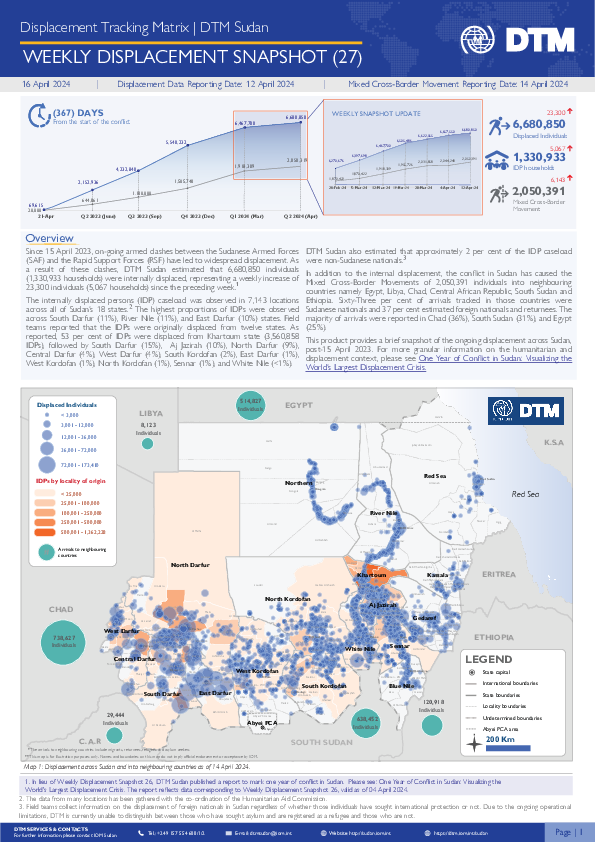
Contact
DTM Sudan; dtmsudan@iom.int
Language
English
Location
Sudan
Period Covered
Apr 05 2024
Apr 12 2024
Activity
- Mobility Tracking
- Baseline Assessment
This report reflects data corresponding to Weekly Displacement Snapshot 27 dataset, valid as of 12 April 2024. The dataset is available here.
Overview
On 15 April 2023, armed clashes erupted between the Sudanese Armed Forces (SAF) and the Rapid Support Forces (RSF) in multiple cities across Sudan. Clashes initially took place in cities across Northern and Khartoum states, later spreading across the Darfur and Kordofan regions.
Highlights
- DTM Sudan estimates that 6,680,850 individuals (1,330,933 households) were recently internally displaced.
- The IDP caseload was observed in 7,143 locations across all of Sudan’s 18 states.
- The highest proportions of IDPs were observed across South Darfur (11%), River Nile (11%), and East Darfur (10%).
- Field teams reported that the IDPs observed were originally displaced from twelve states. The majority (3,560,858 IDPs, 54%) were reportedly displaced from Khartoum state; followed by South Darfur (15%), Aj Jazirah (10%), North Darfur (9%), Central Darfur (4%), West Darfur (4%), South Kordofan (2%), East Darfur (1%), West Kordofan (1%), North Kordofan (1%), Sennar (1%) and White Nile (<1%).
- IOM-DTM also reported that an estimated 2,050,391 mixed cross-border movements were made into neighbouring countries.
- This product provides brief insights into those displaced in Sudan post-15 April 2023. For more granular information on the IDP caseload and the displacement context, please see IOM-DTM's One Year of Conflict in Sudan: Visualizing the World's Largest Displacement Crisis.
Note: In lieu of Weekly Displacement Snapshot 26, DTM Sudan published a report to to mark one year of conflict in Sudan. Please see: One Year of Conflict in Sudan: Visualizing the World's Largest Displacement Crisis. The report reflects data corresponding to Weekly Displacement Snapshot 26 dataset, valid as of 04 April 2024.
Contact
dtmuganda@iom.int vwabwire@iom.in
Location
Uganda
Activity
- Mobility Tracking
- Event Tracking
- Baseline Assessment
Period Covered
Mar 10 2024 -Mar 29 2024
In March, the impacts of the hazards affected 10,390 individuals (2,387 households), with 426 people from 91 households were internally displaced. Children below the age of 18 were the most affected age group (67%), followed by adults (18-64) at 30% and elderly above 64 (3%). Notably, more than half of affected people were female (62%).
A more detailed version of this dataset, including the number of the vulnerabilities, is available. To get access, kindly click on the 'Request Access' button.
Population Groups
IDPs
Residents
Survey Methodology
Unit of Analysis Or Observation
Admin Area 2
Admin Area 3
Community
Type of Survey or Assessment
Key Informant
Keywords
Geographical Scope Partial Coverage
Administrative boundaries with available data
The current dataset covers the following administrative boundaries
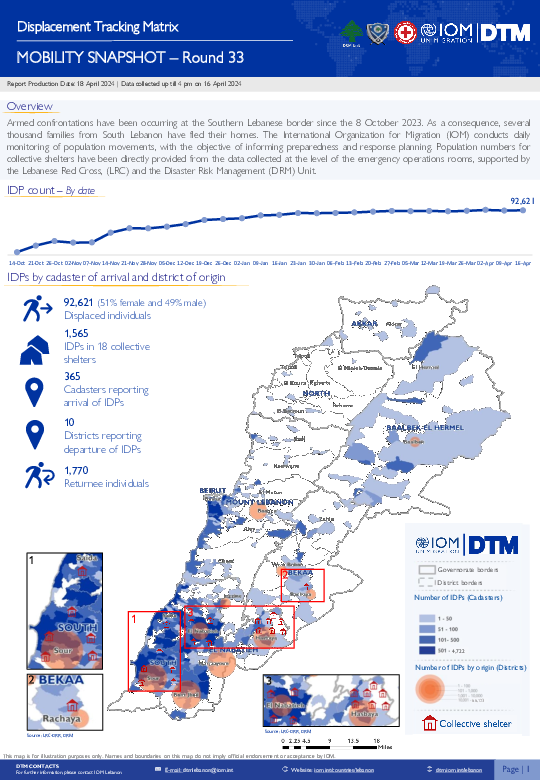
Contact
dtmlebanon@iom.int
Language
English
Location
Lebanon
Period Covered
Oct 10 2023
Apr 16 2024
Activity
- Mobility Tracking
- Baseline Assessment
Since October 8 there has been an increase in cross-border incidents between Israel and Lebanon, resulting in the displacement of people both within the South and elsewhere within the country. Since October 10, the Displacement Tracking Matrix (DTM) has been conducting the daily monitoring of population movements. The objective of the exercise is to inform preparedness and response planning.
Contact
DTM Cameroon, DTMCameroon@iom.int
Location
Cameroon
Activity
- Mobility Tracking
- Baseline Assessment
Period Covered
Aug 18 2023 -Aug 29 2023
Data collection for round 27 was conducted from 18 to 29 August 2023 through 3,715 key informants, accross 1,283 localities. During this round, 700,766 internally displaced individuals were identified, including 453,661 IDPs, 198,940 Returnees, and 48,165 Out-of-camp refugees
Population Groups
IDPs
Migrants Present
Returnee (Previously Displaced Abroad)
Returnee (Previously Internally Displaced)
Survey Methodology
Unit of Analysis Or Observation
Admin Area 4
Type of Survey or Assessment
Key Informant
Keywords
Geographical Scope Partial Coverage
Administrative boundaries with available data
The current dataset covers the following administrative boundaries
Pagination
- Previous page
- Page 32
- Next page
